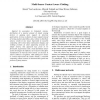Free Online Productivity Tools
i2Speak
i2Symbol
i2OCR
iTex2Img
iWeb2Print
iWeb2Shot
i2Type
iPdf2Split
iPdf2Merge
i2Bopomofo
i2Arabic
i2Style
i2Image
i2PDF
iLatex2Rtf
Sci2ools
ISWC
2002
IEEE
2002
IEEE
Multi-Sensor Context Aware Clothing
Inspired by perception in biological systems, distribution of a massive amount of simple sensing devices is gaining more support in detection applications. A focus on fusion of sensor signals instead of strong analysis algorithms, and a scheme to distribute sensors, results in new issues. Especially in wearable computing, where sensor data continuously changes, and clothing provides an ideal supporting structure for simple sensors, this approach may prove to be favourable. Experiments with a body-distributed sensor system investigate the influence of two factors that affect classification of what has been sensed: an increase in sensors enhances recognition, while adding new classes or contexts depreciates the results. Finally, a wearable computing related scenario is discussed that exploits the presence of many sensors.
| Added | 15 Jul 2010 |
| Updated | 15 Jul 2010 |
| Type | Conference |
| Year | 2002 |
| Where | ISWC |
| Authors | Kristof Van Laerhoven, Albrecht Schmidt, Hans-Werner Gellersen |
Comments (0)

